Chapter One Hundred Twenty-Five
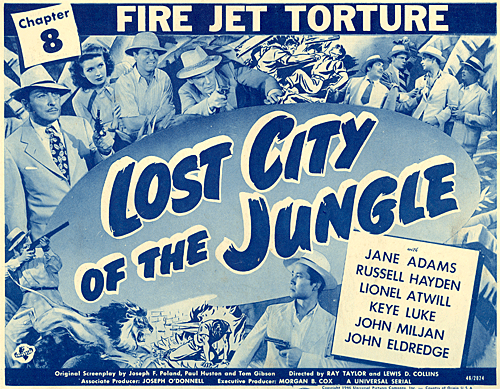
Newspaper column from 1946.
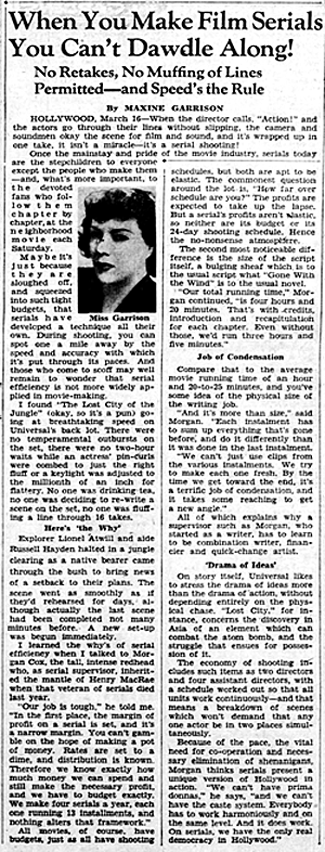
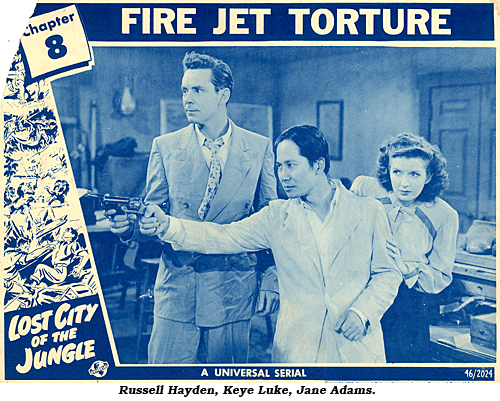
Elmo Lincoln and Jim Thorpe in Serials
In 1950, Bud G. Anderson, owner of Seal Bros. Circus, signed Vern Corriel to do his wire walking, juggling, etc. acts. Corriel, a big E.R.B. and Tarzan fan, visited Elmo
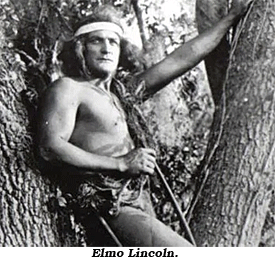 Lincoln at the Motion Picture Home while the show was in winter quarters. Corriel reported to Anderson that Elmo was quite excited about the circus. (Some of his press says he was a strongman before appearing in movies.) Anderson knew a good thing when it stared him in the face, so signed Elmo to Seal Bros. at $75 a week plus room and board. Anderson died in a truck wreck that summer and the show was closed. All advertising proclaimed, “The one and only original Tarzan” with an 8x10 of Elmo, foot on a conquered lion, beating his chest. But to most kids of that time, the “one and only” could only be Weissmuller!?! Not a word in the advertising mentioned Elmo Lincoln. Someone on the show commented that Elmo mostly just rode an elephant while Corriel did commentary on his life. Meanwhile, back at the theatres, “Jim Thorpe, All American” with Burt Lancaster was released by Warner Bros. in 1951. By now, Anderson's son Luke owned the circus, had renamed it Wallace and Clark, and, like his Dad, saw the publicity potential in the real Jim Thorpe and signed him. However, the Indian died of a heart attck in March ‘53 before the show opened for the season. Both Elmo Lincoln and Jim Thorpe had worked in serials. Lincoln starred in two 18 chapter Universal chapterplays in 1919 and 1920, “Elmo the Mighty” and “Elmo the Fearless”. This was followed by “The Flaming Disc” in ‘20, then the immortal “Adventures of
Lincoln at the Motion Picture Home while the show was in winter quarters. Corriel reported to Anderson that Elmo was quite excited about the circus. (Some of his press says he was a strongman before appearing in movies.) Anderson knew a good thing when it stared him in the face, so signed Elmo to Seal Bros. at $75 a week plus room and board. Anderson died in a truck wreck that summer and the show was closed. All advertising proclaimed, “The one and only original Tarzan” with an 8x10 of Elmo, foot on a conquered lion, beating his chest. But to most kids of that time, the “one and only” could only be Weissmuller!?! Not a word in the advertising mentioned Elmo Lincoln. Someone on the show commented that Elmo mostly just rode an elephant while Corriel did commentary on his life. Meanwhile, back at the theatres, “Jim Thorpe, All American” with Burt Lancaster was released by Warner Bros. in 1951. By now, Anderson's son Luke owned the circus, had renamed it Wallace and Clark, and, like his Dad, saw the publicity potential in the real Jim Thorpe and signed him. However, the Indian died of a heart attck in March ‘53 before the show opened for the season. Both Elmo Lincoln and Jim Thorpe had worked in serials. Lincoln starred in two 18 chapter Universal chapterplays in 1919 and 1920, “Elmo the Mighty” and “Elmo the Fearless”. This was followed by “The Flaming Disc” in ‘20, then the immortal “Adventures of 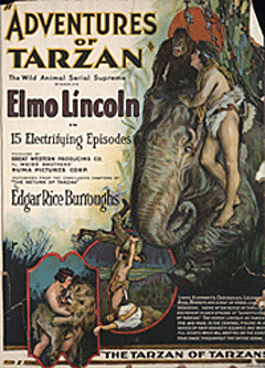 Tarzan” in ‘21 for Great Western. Elmo had previously starred in two Tarzan features, “Tarzan of the Apes” and “Romance of Tarzan” in 1918. The serial became one of the four most popular films of the year! Typecast as the apeman, Lincoln then appeared as a white hunter in “King of the Jungle”, a 1927 cheapie for Rayart, retiring after that but returning to films in bit parts around 1939 when his only serial work was a small role in Columbia’s 15 chapter “Black Arrow” (‘44). He died of a heart attack at 63 in 1952. Thorpe, a member of the Sac and Fox Indian tribes, attended Carlisle University and, during the 1912 Olympic games in Sweden, won both the decathlon and pentathlon championships. However, disclosure of his minor participation in semiprofessional baseball in 1910 at Carlisle deprived him of the gold medals by an apparently prejudiced Olympic committee. (In later years they were reinstated.) Following the Olympics, he played major league baseball and football, then entered films as Chief Swift Arrow in Tom Tyler’s “Battling with Buffalo Bill” serial in 1931. Unable to secure a coaching job, Thorpe drowned his plight in booze for years while continuing to appear in small parts in Westerns and serials—“Red Rider” (‘34), ‘Rustlers of Red Dog’ (‘35), “Phantom Rider” (‘36) and “Oregon Trail” (‘39) serials.
Tarzan” in ‘21 for Great Western. Elmo had previously starred in two Tarzan features, “Tarzan of the Apes” and “Romance of Tarzan” in 1918. The serial became one of the four most popular films of the year! Typecast as the apeman, Lincoln then appeared as a white hunter in “King of the Jungle”, a 1927 cheapie for Rayart, retiring after that but returning to films in bit parts around 1939 when his only serial work was a small role in Columbia’s 15 chapter “Black Arrow” (‘44). He died of a heart attack at 63 in 1952. Thorpe, a member of the Sac and Fox Indian tribes, attended Carlisle University and, during the 1912 Olympic games in Sweden, won both the decathlon and pentathlon championships. However, disclosure of his minor participation in semiprofessional baseball in 1910 at Carlisle deprived him of the gold medals by an apparently prejudiced Olympic committee. (In later years they were reinstated.) Following the Olympics, he played major league baseball and football, then entered films as Chief Swift Arrow in Tom Tyler’s “Battling with Buffalo Bill” serial in 1931. Unable to secure a coaching job, Thorpe drowned his plight in booze for years while continuing to appear in small parts in Westerns and serials—“Red Rider” (‘34), ‘Rustlers of Red Dog’ (‘35), “Phantom Rider” (‘36) and “Oregon Trail” (‘39) serials.
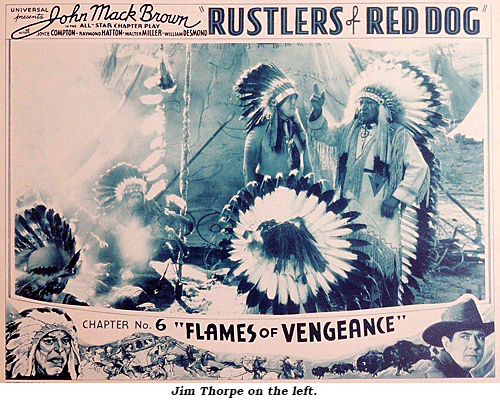

Chapter 1 of “Red Rider” ends as a posse’s horses trample over Buck Jones’ fallen body. In Ch. 2, the horses stop before they ever reach Buck. |
top of page

